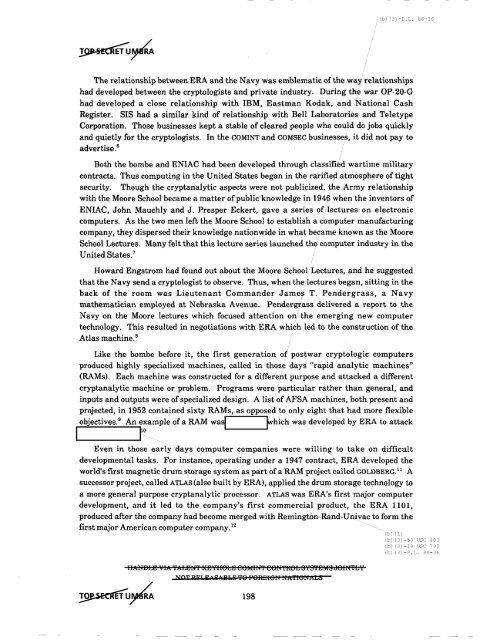American Cryptology during the Cold War - The Black Vault
American Cryptology during the Cold War - The Black Vault
American Cryptology during the Cold War - The Black Vault
You also want an ePaper? Increase the reach of your titles
YUMPU automatically turns print PDFs into web optimized ePapers that Google loves.
Ib) (3) -P.L. 86-36<br />
<strong>The</strong> relationship between ERA and <strong>the</strong> Navy was emblematic of<strong>the</strong> way relationships<br />
had developed between <strong>the</strong> cryptologists and private industry. During <strong>the</strong> war OP-20-G<br />
had developed a close relationship with IBM, Eastman Kodak, and National Cash<br />
Register. SIS had a similar kind of relationship with Bell Laboratories and Teletype<br />
Corporation. Those businesses kept a stable of cleared people who could do jobs quickly<br />
and quietly for <strong>the</strong> cryptologists. In <strong>the</strong> COMINT and COMSEC businesses, it did not pay to<br />
advertise. 6<br />
Both <strong>the</strong> bombe and ENIAC had been developed through classified wartime military<br />
contracts. Thus computing in <strong>the</strong> United States began in <strong>the</strong> rarified atmosphere of tight<br />
security. Though <strong>the</strong> cryptanalytic aspects were not publicized, <strong>the</strong> Army relationship<br />
with <strong>the</strong> Moore School became a matter ofpublic knowledge in 1946 when <strong>the</strong> inventors of<br />
ENIAC, John Mauchly and J. Presper Eckert, gave a series of lectures on electronic<br />
computers. As <strong>the</strong> two men left <strong>the</strong> Moore School to establish a computer manufacturing<br />
company, <strong>the</strong>y dispersed <strong>the</strong>ir knowledge nationwide in what became known as <strong>the</strong> Moore<br />
School Lectures. Many felt that this lecture series launched <strong>the</strong> computer industry in <strong>the</strong><br />
United States. 7<br />
Howard Engstrom had found out about <strong>the</strong> Moore School/Lectures, and he suggested<br />
that <strong>the</strong> Navy send a cryptologist to observe. Thus, when <strong>the</strong>ilectures began, sitting in <strong>the</strong><br />
back of <strong>the</strong> room was Lieutenant Commander James T. Pendergrass, a Navy<br />
ma<strong>the</strong>matician employed at Nebraska Avenue. Pendergrass delivered a report to <strong>the</strong><br />
Navy on <strong>the</strong> Moore lectures which focused attention on <strong>the</strong> emerging new computer<br />
technology. This resulted in negotiations with ERA whiCh led to <strong>the</strong> construction of <strong>the</strong><br />
Atlas machine. 8<br />
Like <strong>the</strong> bombe before it, <strong>the</strong> first generation of postwar cryptologic computers<br />
produced highly specialized machines, called in those days "rapid analytic machines"<br />
(RAMs). Each machine was constructed for a different purpose and attacked a different<br />
cryptanalytic machine or problem. Programs were /particular ra<strong>the</strong>r than general, and<br />
inputs and outputs were of specialized design. A listof AFSA machines, both present and<br />
projected, in 1952 contained sixty RAMs, as opposed to only eight that had more flexible<br />
objectives. 9 An example ofa RAM wa~ rhich was developed by ERA to attack<br />
I<br />
to<br />
Even in those early days computer companies were willing to take on difficult<br />
developmental tasks. For instance, ()perating under a 1947 contract, ERA developed <strong>the</strong><br />
world's first magnetic drum storage system~spart ofa RAM project called GOLDBERG. ll A<br />
successor project, called ATLAS (also built by ERA), (ipplied <strong>the</strong> drum storage technology to<br />
a more general purpose cryptanalytic processor. ATL.A.Sw(iS ERA's first major computer<br />
development, and it led to <strong>the</strong> company's first commercialprQduct, <strong>the</strong> ERA 1101,<br />
produced after <strong>the</strong> company had become merged with Remington-Rand~Univacto form <strong>the</strong><br />
first major <strong>American</strong> computer company.12<br />
Ib) (1)<br />
Ib) (3) -50 USC 403<br />
Ib) (3) -18 USC 798<br />
Ib) (3) -P.L. 86-36<br />
IIANBhe VIA 'Hl:heN'f lEe {fI6he e6MHf'f e6H'fft6h S?S'feMS66Hf'fL?<br />
NOT REI E A i A Qbg ~9 F9RI"JI6N lifATIONALS<br />
198
















